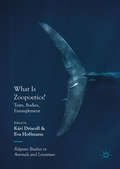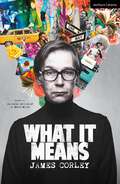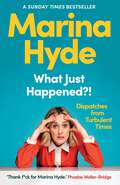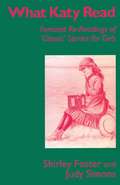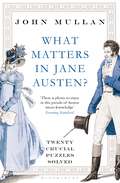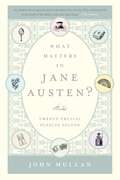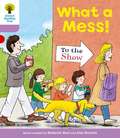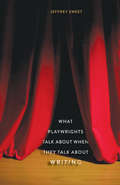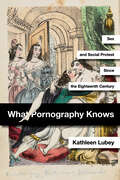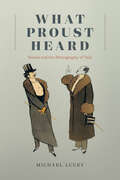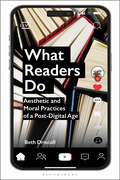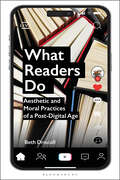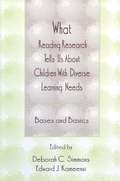- Table View
- List View
What Is Zoopoetics?: Texts, Bodies, Entanglement (Palgrave Studies in Animals and Literature)
by Kári Driscoll Eva HoffmannThis book brings together essays dealing with the question of zoopoetics both as an object of study—i.e. texts from various traditions and periods that reflect, explicitly or implicitly, on the relationship between animality, language and representation—and as a methodological problem for animal studies, and, indeed, for literary studies more generally. What can literary animal studies tell us about literature that conventional literary studies might be blind to? How can literary studies resist the tendency to press animals into symbolic service as metaphors and allegories for the human whilst also avoiding a naïve literalism with respect to the literary animal? The volume is divided into three sections: “Texts,” which focuses on the linguistic and metaphorical dimensions of zoopoetics; “Bodies,” which is primarily concerned with mimesis and questions of embodiment, performance, and lived experience; and “Entanglement,” which focuses on interspecies encounters and the complex interplay between word and world that emerges from them. The volume will appeal to scholars and students in the fields of animal studies, area studies and comparative literature, gender studies, environmental humanities, ecocriticism, and the broader field of posthumanism.
What it Means: Based on On Being Different by Merle Miller (Modern Plays)
by James CorleyThey say they've broken into the offices of Harper's Magazine and are staging a sit-inSeptember 1970, Harper's Magazine publish the article Homo/Hetero: The Struggle for Sexual Identity in which Joseph Epstein states "If I had the power to do so, I would wish homosexuality off the face of the earth". The Gay Activists Alliance stage a sit-in at the Harper's office. But there are many ways to protest. In his Glass House, hidden in the woods outside Brewster New York, Merle Miller - acclaimed journalist and former editor of Harper's Magazine - sits at his desk and begins to write. An emotional one-person voyage through history - some personal, some not - What It Means speaks directly to audiences about the importance of standing up for what you believe in, accepting the validity of one's own voice and taking a courageous step onto the platform that is offered to you. This edition was published to coincide with the world premiere stage production at Wilton's Music Hall in October 2023, from The Lot Productions.
What it Means: Based on On Being Different by Merle Miller (Modern Plays)
by James CorleyThey say they've broken into the offices of Harper's Magazine and are staging a sit-inSeptember 1970, Harper's Magazine publish the article Homo/Hetero: The Struggle for Sexual Identity in which Joseph Epstein states "If I had the power to do so, I would wish homosexuality off the face of the earth". The Gay Activists Alliance stage a sit-in at the Harper's office. But there are many ways to protest. In his Glass House, hidden in the woods outside Brewster New York, Merle Miller - acclaimed journalist and former editor of Harper's Magazine - sits at his desk and begins to write. An emotional one-person voyage through history - some personal, some not - What It Means speaks directly to audiences about the importance of standing up for what you believe in, accepting the validity of one's own voice and taking a courageous step onto the platform that is offered to you. This edition was published to coincide with the world premiere stage production at Wilton's Music Hall in October 2023, from The Lot Productions.
What Jane Austen's Characters Read (and Why)
by Susan Allen FordThe first detailed account of Austen's characters' reading experience to date, this book explores both what her characters read and what their literary choices would have meant to Austen's own readership, both during her life and today.Jane Austen was a voracious and extensive reader, so it's perhaps no surprise that many of her characters are also readers-from Mr. Collins in Pride and Prejudice to Fanny Price in Mansfield Park. Beginning by looking at Austen's own reading as well as her interest in readers' responses to her work, the book then focuses on each of her novels, looking at the particulars of her characters' reading and unpacking the multiple (and often surprising) ways in which what they read informs our reading. What Jane Austen's Characters Read (and Why) uses Austen's own love of reading to invite us to rethink the ways in which she imagined her characters and their lives beyond the novels.
What Jane Austen's Characters Read (and Why)
by Susan Allen FordThe first detailed account of Austen's characters' reading experience to date, this book explores both what her characters read and what their literary choices would have meant to Austen's own readership, both during her life and today.Jane Austen was a voracious and extensive reader, so it's perhaps no surprise that many of her characters are also readers-from Mr. Collins in Pride and Prejudice to Fanny Price in Mansfield Park. Beginning by looking at Austen's own reading as well as her interest in readers' responses to her work, the book then focuses on each of her novels, looking at the particulars of her characters' reading and unpacking the multiple (and often surprising) ways in which what they read informs our reading. What Jane Austen's Characters Read (and Why) uses Austen's own love of reading to invite us to rethink the ways in which she imagined her characters and their lives beyond the novels.
What Just Happened?!: Dispatches from Turbulent Times
by Marina HydeRelive the delusional fever-dream of the modern era.'Thank f*ck for Marina Hyde: the most lethal, vital, screamingly funny truth-teller of our time.'PHOEBE WALLER-BRIDGE'The most brilliantly funny columnist of our time.'GARY LINEKER'It's a scientific FACT: Marina Hyde is Britain's funniest writer.'CAITLIN MORANNo other writer is more suited to chronicling the absurd times in which we live.In What Just Happened?! Marina Hyde slashes her way through the hellscape of post-referendum politics, where the chaos never stops. Clamber aboard as we relive every inspirational moment of magic, from David Cameron to Theresa May to Boris Johnson. Marvel at the sights, from Trumpian WTF-ery to celebrity twattery. And boggle at the cast of characters: Hollywood sex offenders, populists, sporting heroes (and villains), dastardly dukes, media barons, movie stars, reality TV monsters, billionaires, police officers, various princes and princesses, wicked advisers, philanthropists, fauxlanthropists, telly chefs, and (naturally) Gwyneth Paltrow. It's the full state banquet of crazy - and you're most cordially invited.Drawn from her spectacularly funny Guardian columns, What Just Happened?! is a welcome blast of humour and sanity in a world where reality has become stranger than fiction.'A joyous rallying voice in British journalism.'GRAYSON PERRY'An infinite number of gag-writers, working all day in a gag factory, couldn't come up with any of the perfectly-formed one-liners that populate Marina Hyde's hilarious writing . . . But behind the wit lurks real anger, argument, exasperation and intelligence. Her writing is more than a gentle poke in the ribs: it's a well-wrought and deftly aimed smash in the teeth.'ARMANDO IANNUCCI
What Katy Read: Feminist Re-Readings of ‘Classic’ Stories for Girls
by Shirley Foster Judy SimonsWhat Katy Read focuses on a much neglected area of literary criticism: literature for girls. Written by women for children, such texts have been doubly marginalized by the critical establishment. Shirley Foster and Judy Simons use twentieth-century feminist critical practice to open up fresh perspectives on popular fiction for girls written between 1850 and 1920. The study analyses both American and British novels for girls which have acquired 'classic' status, from the domestic myth to the school story, and considers their scope and influence in providing role models for girl readers.
What Makes an Apple?: Six Conversations about Writing, Love, Guilt, and Other Pleasures
by Amos OzRevelatory talks about art and life with internationally acclaimed Israeli novelist Amos OzIn the last years of his life, the writer Amos Oz talked regularly with Shira Hadad, who worked closely with him as the editor of his final novel, Judas. These candid, uninhibited dialogues show a side of Oz that few ever saw. What Makes an Apple? presents the most revealing of these conversations in English for the first time, painting an illuminating and disarmingly intimate portrait of a towering literary figure.In frank and open exchanges that are by turns buoyant, introspective, and argumentative, Oz explains what impels him to begin a story and shares his routines, habits, and challenges as a writer. He discusses the tectonic changes he experienced in his lifetime in relationships between women and men, and describes how his erotic coming of age shaped him not only as a man but also as an author. Oz reflects on his parents, his formative years on a kibbutz, and how he dealt with and learned from his critics, his students, and his fame. He talks about why there is more humor in his later books and gives his exceptional take on fear of death.Resonating with Oz’s clear, honest, and humorous voice, What Makes an Apple? offers unique insights about Oz’s artistic and personal evolution, and enables readers to explore his work in new ways.
What Makes an Apple?: Six Conversations about Writing, Love, Guilt, and Other Pleasures
by Amos OzRevelatory talks about art and life with internationally acclaimed Israeli novelist Amos OzIn the last years of his life, the writer Amos Oz talked regularly with Shira Hadad, who worked closely with him as the editor of his final novel, Judas. These candid, uninhibited dialogues show a side of Oz that few ever saw. What Makes an Apple? presents the most revealing of these conversations in English for the first time, painting an illuminating and disarmingly intimate portrait of a towering literary figure.In frank and open exchanges that are by turns buoyant, introspective, and argumentative, Oz explains what impels him to begin a story and shares his routines, habits, and challenges as a writer. He discusses the tectonic changes he experienced in his lifetime in relationships between women and men, and describes how his erotic coming of age shaped him not only as a man but also as an author. Oz reflects on his parents, his formative years on a kibbutz, and how he dealt with and learned from his critics, his students, and his fame. He talks about why there is more humor in his later books and gives his exceptional take on fear of death.Resonating with Oz’s clear, honest, and humorous voice, What Makes an Apple? offers unique insights about Oz’s artistic and personal evolution, and enables readers to explore his work in new ways.
What Makes This Book So Great: Re-Reading the Classics of Fantasy and SF
by Jo WaltonJo Walton is an award-winning author of, inveterate reader of, and chronic re-reader of science fiction and fantasy books. What Makes This Book So Great? is a selection of the best of her musings about her prodigious reading habit. Jo Walton’s many subjects range from acknowledged classics, to guilty pleasures, to forgotten oddities and gems. Among them, the Zones of Thought novels of Vernor Vinge; the question of what genre readers mean by ‘mainstream’; the under-appreciated SF adventures of C. J. Cherryh; the field’s many approaches to time travel; the masterful science fiction of Samuel R. Delany; Salman Rushdie’s Midnight’s Children; the early Hainish novels of Ursula K. Le Guin; and a Robert A. Heinlein novel you have most certainly never read. Over 130 essays in all, What Makes This Book So Great is an immensely engaging collection of provocative, opinionated thoughts about past and present-day fantasy and science fiction, from one of our best writers.
What Matters in Jane Austen?: Twenty Crucial Puzzles Solved
by John MullanWhat are the right and wrong ways to propose marriage?What do the characters call each other, and why?And which important Austen characters never speak? In twenty short chapters, each of which answers a question prompted by Jane Austen's novels, John Mullan illuminates the themes that matter most to the workings of Austen's fiction. Inspired by an enthusiastic reader's curiosity, based on a lifetime's study and written with flair and insight, What Matters in Jane Austen? uncovers the hidden truth about an extraordinary fictional world.
What Matters in Jane Austen?: Twenty Crucial Puzzles Solved
by John MullanWhich important Austen characters never speak? Is there any sex in Austen? What do the characters call one another, and why? What are the right and wrong ways to propose marriage? In What Matters in Jane Austen?, John Mullan shows that we can best appreciate Austen's brilliance by looking at the intriguing quirks and intricacies of her fiction. Asking and answering some very specific questions about what goes on in her novels, he reveals the inner workings of their greatness.??In twenty short chapters, each of which explores a question prompted by Austens novels, Mullan illuminates the themes that matter most in her beloved fiction. Readers will discover when Austen's characters had their meals and what shops they went to; how vicars got good livings; and how wealth was inherited. What Matters in Jane Austen? illuminates the rituals and conventions of her fictional world in order to reveal her technical virtuosity and daring as a novelist. It uses telling passages from Austen's letters and details from her own life to explain episodes in her novels: readers will find out, for example, what novels she read, how much money she had to live on, and what she saw at the theater.??Written with flair and based on a lifetime's study, What Matters in Jane Austen? will allow readers to appreciate Jane Austen's work in greater depth than ever before.
What A Mess! (Oxford Reading Tree Biff, Chip And Kipper Stories Ser.)
by Roderick Hunt Alex Brychta Gill HowellWhat Nails It (Why I Write)
by Greil MarcusFrom a celebrated critic, a heartfelt and adventurous reflection on the art of writing about art “Essential for fans of Marcus and fruitful reading for anyone reflecting on the mysteries of art.”—Kirkus Reviews (starred review) “Writers write. They can’t help it. They can’t not.” In this spirited book, the revered cultural critic Greil Marcus explains his compulsion as a yearning for fun, for play, and, most of all, to discover—to feel the moment when a creation speaks in its own voice. Marcus reflects on over half a century spent honing the art of attention—from his California childhood, overshadowed by mystery and silence surrounding his father’s death, to his discovery of the critic Pauline Kael, to a confrontation with a sixteenth-century painting in Venice. Through it all, he invites readers to join him in exploring the revolutionary power of art: what it is, why it captures us, and how it forces us to confront what we think we know and who we think we are. Art challenges us to see the world differently, Marcus argues, and the role of the critic is to enact this perspective. Funny and poignant, What Nails It is a tribute to the indispensable art of criticism by one of its greatest practitioners.
What Playwrights Talk About When They Talk About Writing
by Jeffrey SweetThe art and craft of playwriting as explored in candid conversations with some of the most important contemporary dramatists Edward Albee, Lanford Wilson, Lynn Nottage, A. R. Gurney, and a host of other major creative voices of the theater discuss the art of playwriting, from inspiration to production, in a volume that marks the tenth anniversary of the Yale Drama Series and the David Charles Horn Foundation Prize for emerging playwrights. Jeffrey Sweet, himself an award-winning dramatist, hosts a virtual roundtable of perspectives on how to tell stories onstage featuring extensive interviews with a gallery of gifted contemporary dramatists. In their own words, Arthur Kopit, Marsha Norman, Christopher Durang, David Hare, and many others offer insights into all aspects of the creative writing process as well as their personal views on the business, politics, and fraternity of professional theater. This essential work will give playwrights and playgoers alike a deeper and more profound appreciation of the art form they love.
What Pornography Knows: Sex and Social Protest since the Eighteenth Century
by Kathleen LubeyWhat Pornography Knows offers a new history of pornography based on forgotten bawdy fiction of the eighteenth century, its nineteenth-century republication, and its appearance in 1960s paperbacks. Through close textual study, Lubey shows how these texts were edited across time to become what we think pornography is—a genre focused primarily on sex. Originally, they were far more variable, joining speculative philosophy and feminist theory to sexual description. Lubey's readings show that pornography always had a social consciousness—that it knew, long before anti-pornography feminists said it, that women and nonbinary people are disadvantaged by a society that grants sexual privilege to men. Rather than glorify this inequity, Lubey argues, the genre's central task has historically been to expose its artifice and envision social reform. Centering women's bodies, pornography refuses to divert its focus from genital action, forcing readers to connect sex with its social outcomes. At times inventing their own sexual anatomy and gender identity, at times having their bodies claimed and used by others, pornographic figures bring genitals to the fore, insisting they be justly treated rather than coldly transacted. Lubey offers a surprising take on a deeply misunderstood cultural form: pornography transforms sexual description into feminist commentary, she argues, revealing the genre's deep knowledge of how social inequities are perpetuated as well as plans for how to rectify them.
What Pornography Knows: Sex and Social Protest since the Eighteenth Century
by Kathleen LubeyWhat Pornography Knows offers a new history of pornography based on forgotten bawdy fiction of the eighteenth century, its nineteenth-century republication, and its appearance in 1960s paperbacks. Through close textual study, Lubey shows how these texts were edited across time to become what we think pornography is—a genre focused primarily on sex. Originally, they were far more variable, joining speculative philosophy and feminist theory to sexual description. Lubey's readings show that pornography always had a social consciousness—that it knew, long before anti-pornography feminists said it, that women and nonbinary people are disadvantaged by a society that grants sexual privilege to men. Rather than glorify this inequity, Lubey argues, the genre's central task has historically been to expose its artifice and envision social reform. Centering women's bodies, pornography refuses to divert its focus from genital action, forcing readers to connect sex with its social outcomes. At times inventing their own sexual anatomy and gender identity, at times having their bodies claimed and used by others, pornographic figures bring genitals to the fore, insisting they be justly treated rather than coldly transacted. Lubey offers a surprising take on a deeply misunderstood cultural form: pornography transforms sexual description into feminist commentary, she argues, revealing the genre's deep knowledge of how social inequities are perpetuated as well as plans for how to rectify them.
What Postcolonial Theory Doesn't Say (Routledge Research in Postcolonial Literatures)
by Stuart Murray Ziad Elmarsafy Anna BernardThis book reclaims postcolonial theory, addressing persistent limitations in the geographical, disciplinary, and methodological assumptions of its dominant formations. It emerges, however, from an investment in the future of postcolonial studies and a commitment to its basic premise: namely, that literature and culture are fundamental to the response to structures of colonial and imperial domination. To a certain extent, postcolonial theory is a victim of its own success, not least because of the institutionalization of the insights that it has enabled. Now that these insights no longer seem new, it is hard to know what the field should address beyond its general commitments. Yet the renewal of popular anti-imperial energies across the globe provides an important opportunity to reassert the political and theoretical value of the postcolonial as a comparative, interdisciplinary, and oppositional paradigm. This collection makes a claim for what postcolonial theory can say through the work of scholars articulating what it still cannot or will not say. It explores ideas that a more aesthetically sophisticated postcolonial theory might be able to address, focusing on questions of visibility, performance, and literariness. Contributors highlight some of the shortcomings of current postcolonial theory in relation to contemporary political developments such as Zimbabwean land reform, postcommunism, and the economic rise of Asia. Finally, they address the disciplinary, geographical, and methodological exclusions from postcolonial studies through a detailed focus on new disciplinary directions (management studies, international relations, disaster studies), overlooked locations and perspectives (Palestine, Weimar Germany, the commons), and the necessity of materialist analysis for understanding both the contemporary world and world literary systems.
What Postcolonial Theory Doesn't Say (Routledge Research in Postcolonial Literatures)
by Stuart Murray Ziad Elmarsafy Anna BernardThis book reclaims postcolonial theory, addressing persistent limitations in the geographical, disciplinary, and methodological assumptions of its dominant formations. It emerges, however, from an investment in the future of postcolonial studies and a commitment to its basic premise: namely, that literature and culture are fundamental to the response to structures of colonial and imperial domination. To a certain extent, postcolonial theory is a victim of its own success, not least because of the institutionalization of the insights that it has enabled. Now that these insights no longer seem new, it is hard to know what the field should address beyond its general commitments. Yet the renewal of popular anti-imperial energies across the globe provides an important opportunity to reassert the political and theoretical value of the postcolonial as a comparative, interdisciplinary, and oppositional paradigm. This collection makes a claim for what postcolonial theory can say through the work of scholars articulating what it still cannot or will not say. It explores ideas that a more aesthetically sophisticated postcolonial theory might be able to address, focusing on questions of visibility, performance, and literariness. Contributors highlight some of the shortcomings of current postcolonial theory in relation to contemporary political developments such as Zimbabwean land reform, postcommunism, and the economic rise of Asia. Finally, they address the disciplinary, geographical, and methodological exclusions from postcolonial studies through a detailed focus on new disciplinary directions (management studies, international relations, disaster studies), overlooked locations and perspectives (Palestine, Weimar Germany, the commons), and the necessity of materialist analysis for understanding both the contemporary world and world literary systems.
What Proust Heard: Novels and the Ethnography of Talk
by Michael LuceyMichael Lucey offers a linguistic anthropological analysis of Proust’s In Search of Lost Time. What happens when we talk? This deceptively simple question is central to Marcel Proust’s monumental novel In Search of Lost Time. Both Proust’s narrator and the novel that houses him devote considerable energy to investigating not just what people are saying or doing when they talk, but also what happens socioculturally through their use of language. Proust, in other words, is interested in what linguistic anthropologists call language-in-use. Michael Lucey elucidates Proust’s approach to language-in-use in a number of ways: principally in relation to linguistic anthropology, but also in relation to speech act theory, and to Pierre Bourdieu’s sociology. The book also includes an interlude after each of its chapters that contextualizes Proust’s social-scientific practice of novel writing in relation to that of a number of other novelists, earlier and later, and from several different traditions, including Honoré de Balzac, George Eliot, Virginia Woolf, Nathalie Sarraute, and Rachel Cusk. Lucey is thus able to show how, in the hands of quite different novelists, various aspects of the novel form become instruments of linguistic anthropological analysis. The result introduces a different way of understanding language to literary and cultural critics and explores the consequences of this new understanding for the practice of literary criticism more generally.
What Readers Do: Aesthetic and Moral Practices of a Post-Digital Age
by Dr Beth DriscollShining a spotlight on everyday readers of the 21st century, Beth Driscoll explores how contemporary readers of Anglophone fiction interact with the book industry, digital environments, and each other.We live in an era when book clubs, bibliomemoirs, Bookstagram and BookTok are as valuable to some readers as solitary reading moments. The product of nearly two decades of qualitative research into readers and reading culture, What Readers Do examines reading through three dimensions - aesthetic conduct, moral conduct, and self-care – to show how readers intertwine private and social behaviors, and both reinforce and oppose the structures of capitalism. Analyzing reading as a post-digital practice that is a synthesis of both print and digital modes and on- and offline behaviors, Driscoll presents a methodology for studying readers that connects book history, literary studies, sociology, and actor-network theory. Arguing for the vitality, agency, and creativity of readers, this book sheds light on how we read now - and on how much more readers do than just read.
What Readers Do: Aesthetic and Moral Practices of a Post-Digital Age
by Dr Beth DriscollShining a spotlight on everyday readers of the 21st century, Beth Driscoll explores how contemporary readers of Anglophone fiction interact with the book industry, digital environments, and each other.We live in an era when book clubs, bibliomemoirs, Bookstagram and BookTok are as valuable to some readers as solitary reading moments. The product of nearly two decades of qualitative research into readers and reading culture, What Readers Do examines reading through three dimensions - aesthetic conduct, moral conduct, and self-care – to show how readers intertwine private and social behaviors, and both reinforce and oppose the structures of capitalism. Analyzing reading as a post-digital practice that is a synthesis of both print and digital modes and on- and offline behaviors, Driscoll presents a methodology for studying readers that connects book history, literary studies, sociology, and actor-network theory. Arguing for the vitality, agency, and creativity of readers, this book sheds light on how we read now - and on how much more readers do than just read.
What Reading Research Tells Us About Children With Diverse Learning Needs: Bases and Basics (The LEA Series on Special Education and Disability)
by Deborah C. Simmons Edward J. KameenuiThe purpose of this book is to communicate findings of a research synthesis investigating the bases of reading failure and the curricular and instructional basics to help guide the design and advancement of children's reading performance. The synthesis--completed by the National Center to Improve the Tools of Educators (NCITE) and sponsored by the U.S. Department of Education's Office of Special Education Programs--was conducted as part of NCITE's mission to improve the quality of educational tools that largely shape practice in American schools.
What Reading Research Tells Us About Children With Diverse Learning Needs: Bases and Basics (The LEA Series on Special Education and Disability)
by Deborah C. Simmons Edward J. KameenuiThe purpose of this book is to communicate findings of a research synthesis investigating the bases of reading failure and the curricular and instructional basics to help guide the design and advancement of children's reading performance. The synthesis--completed by the National Center to Improve the Tools of Educators (NCITE) and sponsored by the U.S. Department of Education's Office of Special Education Programs--was conducted as part of NCITE's mission to improve the quality of educational tools that largely shape practice in American schools.
What Really Happens in Vegas: Discover the infamous city as you’ve never seen it before
by James Patterson'James Patterson and Mark Seal have brought Sin City to life' TELEGRAPHWhat happens in Vegas stays in Vegas - until now.Whether you're a Vegas regular or have only heard the city's tales through whispers, this book will surprise and astound you . . . It's not just the five-star dining, or the casinos, or the clubs, or the crowds. It's the electrifying chemistry of America's most round-the-clock city.In this dazzling 24-hour journey, James Patterson lifts the lid on America's notorious hub of gambling and excess. Fuelled by original interviews and in-depth reporting, What Really Happens in Vegas uncovers the vice, crime and entertainment that made Sin City an infamous desert mecca.This is Vegas as you've never seen it before, filled with unbelievable stories from the people who make the city tick, simmer - and even explode._____________________________PRAISE FOR JAMES PATTERSON'Patterson knows where our deepest fears are buried... there's no stopping his imagination' NEW YORK TIMES BOOK REVIEW'A writer with an unusual skill at thriller plotting' GUARDIAN'The master storyteller of our times' HILLARY RODHAM CLINTON'No one gets this big without amazing natural storytelling talent - which is what Jim has, in spades' LEE CHILD'Patterson boils a scene down to the single, telling detail, the element that defines a character or moves a plot along. It's what fires off the movie projector in the reader's mind' MICHAEL CONNELLY'James Patterson is The Boss. End of.' IAN RANKIN'It's no mystery why James Patterson is the world's most popular thriller writer ... Simply put: nobody does it better' JEFFREY DEAVER
